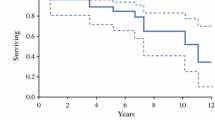Opinion statement
The only definitive therapy for patients with pheochromocytoma is surgical resection [1,2]. Advances in preoperative medical management of hypertension/hypovolemia and improved intraoperative anesthetic care have reduced the operative mortality rate for pheochromocytoma to less than 5% in most series [3]. In addition, accurate preoperative localization studies have eliminated the need for extensive exploratory laparotomy. Focused approach and laparoscopic resection have become the new “gold standard,” with a reduced morbidity [4]. Large or locally invasive pheochromocytomas may still require open resection.
Similar content being viewed by others
References and Recommended Reading
Kebebew EK, Duh QY: Benign and malignant pheochromocytoma: diagnosis, treatment, and follow-up. Surg Oncol Clin North Am 1998, 7:765–789.
Pacak K, Linehan WM, Eisenhofer G, et al.: Recent advances in genetics, diagnosis, localization, and treatment of pheochromocytoma. Ann Intern Med 2001, 134:315–329. This article presents an edited summary of a clinical staff conference on pheochromocytoma at the National Institutes of Health in September, 1999.
Plouin PF, Duclos JM, Soppelsa F, et al.: Factors associated with perioperative morbidity and mortality in patients with pheochromocytoma: analysis of 165 operatives at a single center. J Clin Endocrinol Metab 2001, 86:1480–1486.
Duh QY: Editorial: evolving surgical management for patients with pheochromocytoma. J Clin Endocrinol Metab 2001, 86:1477–1479. This editorial chronicles the evolving therapeutic approach to pheochromocytoma based on technologic and pharmacologic advances.
Lenders JWM, Keiser HR, Goldstein DS, et al.: Plasma metanephrines in the diagnosis of pheochromocytoma. Ann Intern Med 1995, 123:101–109.
Eisenhofer G, Lenders JWM, Linehan WM, et al.: Plasma normetanephrine and metanephrine for detecting pheochromocytoma in von Hippel-Lindau disease and multiple endocrine neoplasia type 2. N Engl J Med 1999, 340:1872–1879.
Quint LE, Glazer GM, Francis IR, et al.: Pheochromocytoma and paraganglioma: comparison of MR imaging with CT and I-131 MIBG scintigraphy. Radiology 1987, 165:89–93.
Godellas CV, Prinz RA: Surgical approach to adrenal neoplasms: laparoscopic versus open adrenalectomy. Surg Oncol Clin North Am 1998, 7:807–817.
Tanaka M, Tokuda N, Koga H, et al.: Laparoscopic adrenalectomy for pheochromocytoma: comparison with open adrenalectomy and comparison of laparoscopic surgery for pheochromocytoma versus other adrenal tumors. J Endourol 2000, 14:427–430.
Mobius E, Nies C, Rothmund M: Surgical treatment of pheochromocytomas: laparoscopic or conventional? Surg Endosc 1999, 13:35–39. This study prospectively collected data on nine patients undergoing laparoscopic adrenalectomy for pheochromocytoma and compared them with nine historical controls who underwent open adrenalectomy.
Gagner M, Breton G, Pharand D, et al.: Is laparoscopic adrenalectomy indicated for pheochromocytomas? Surgery 1996, 120:1076–1080.
Inabnet WB, Pitre J, Bernard D, et al.: Comparison of the hemodynamic parameters of open and laparoscopic adrenalectomy for pheochromocytoma. World J Surg 2000, 24:574–578.
Duh QY, Siperstein AE, Clark OH, et al.: Laparoscopic adrenalectomy: comparison of the lateral and posterior approaches. Arch Surg 1996, 131:870–876.
Smith CD, Weber CJ, Amerson JR: Laparoscopic adrenalectomy: new gold standard. World J Surg 1999, 23:389–396.
Siperstein AE, Berber E, Engle KL, et al.: Laparoscopic posterior adrenalectomy: technical considerations. Arch Surg 2000, 135:967–971.
Bonjer HJ, Sorm V, Berends FJ, et al.: Endoscopic retroperitoneal adrenalectomy: lessons learned form 111 consecutive cases. Ann Surg 2000, 232:796–803.
Krempf M, Lumbrosos J, Mornex R, et al.: Use of m-[I-131]iodobenzylguandidine in the treatment of malignant pheochromocytoma. J Clin Endocrinol Metab 1991, 72:455–461.
Averbuch SD, Steakley CS, Young RC, et al.: Malignant pheochromocytoma: effective treatment with a combination of cyclophosphamide, vincristine, and dacarbazine. Ann Intern Med 1988, 109:267–273.
Author information
Authors and Affiliations
Rights and permissions
About this article
Cite this article
Eigelberger, M.S., Duh, QY. Pheochromocytoma. Curr. Treat. Options in Oncol. 2, 321–329 (2001). https://doi.org/10.1007/s11864-001-0025-5
Issue Date:
DOI: https://doi.org/10.1007/s11864-001-0025-5




